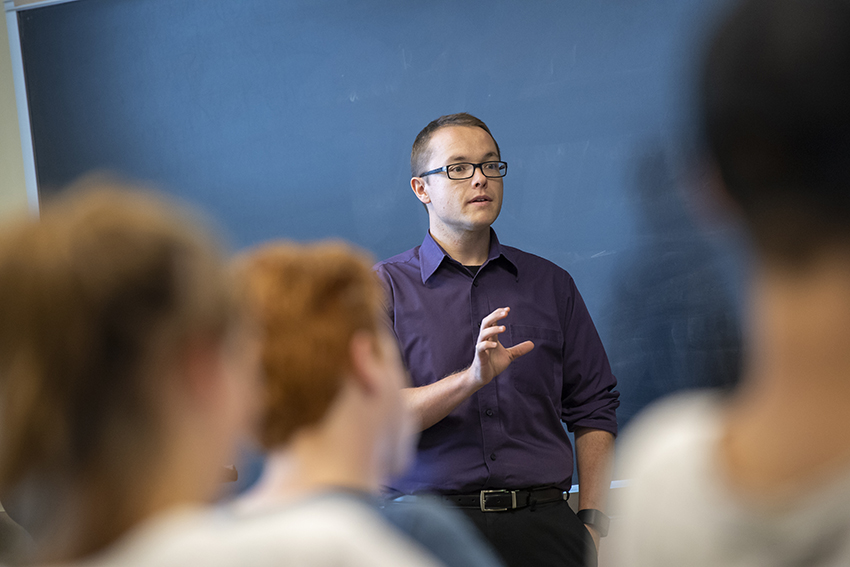The Alternative Facts of Life
This Ancient Near East scholar’s research on two American young-Earth-creationist institutions provided fodder for timely discussions in the classroom.By: Gina Gallucci-White Thursday, April 4, 2019 01:32 PM

While preparing the syllabus for his first-year seminar—Proving the Unprovable: Religion, Science and the 'Unknown' in Modernity—Dustin Nash, assistant professor of religion studies, knew he wanted to include a discussion of creationism.
With the help of a new course development grant from the College’s Faculty Center for Teaching and funding from the Department of Religion Studies, Nash traveled to two institutions in Kentucky: the Creation Museum in Petersburg and Ark Encounter in Williamstown. He planned to take photos so his students could examine how exhibits in both locations made arguments.
"The thing that struck me was: In a museum that is about the Bible, why are there so many dinosaurs?" he says. "You can't throw a rock without hitting a dinosaur at the Creation Museum. They are everywhere."
Nash returned with more than 300 pictures—including some that, at first glance, might have been taken at the American Museum of Natural History—plus countless pages of notes and a desire to dig deeper.
Originally trained as a scholar in the Ancient Near East, the Hebrew Bible and Jewish studies, Nash spent two years researching young-Earth-creationist institutions like the two in Kentucky, whose curators believe the planet is roughly 6,000 years old and deny the validity of evolution, the Big Bang Theory or any notion of physical cosmology.
“They argue that science confirms the historicity of the biblical narrative of the world's origin,” he says. “If you are going to claim that the Earth is only a few thousand years old, then you have to reckon with material paleontological facts. We have dinosaur bones, so they have incorporated paleontology and geology, but reinterpreted it to support their narrative about the past in a way that is unfamiliar to a lot of people.” This means that dinosaurs are included in the institutions’ exhibits on Noah’s Ark and the Garden of Eden.
“Both the Creation Museum and the Ark Encounter spend a great deal of time explaining why they are reinterpreting the paleontological evidence the way that they are,” Nash adds. “There is a day's worth of reading at both sites that communicate this information.”
But, he says, both institutions incorporate other ancient artifacts that mainstream scholars would date differently than young-Earth creationists. Those artifacts create a chronological problem the museums’ curators leave largely unexplained.
Nash presented his findings this summer at the 64th Rencontre Assyriologique Internationale, a conference on Assyriology and Near Eastern archaeology, at Austria’s University of Innsbruck. He was one of 10 speakers at the workshop “(Mis)use of Sources: Ancient and Modern.” He says his research was warmly received, and that many European scholars focusing on the Ancient Near East were not aware of this movement in American culture.
In the age of 'fake news' and 'alternative facts,’ Nash's research encourages thinking about how interpretation plays a role in the creation of knowledge. "What I tell my students frequently is that facts don't have inherent meaning, but they are given meaning in particular context," he says. "What this really shows is interpretation allows for a great deal of data or facts to be aligned with a preexisting ideology."
His research also refutes the common critique that accepting young-Earth creationism is “a matter of not being intelligent,” Nash says. “A lot of people who work at the Creation Museum have Ph.Ds. They are highly intelligent, so just having more information and more accurate information will not solve the issue of, say, alternative facts.”
His next step is continuing to share his work; his article, “Witnessing Dinosaurs and Fossilized Jews at the Creation Museum: Public Memory, Memory Places and the Future of Jewish-Evangelical Relations in America,” has been submitted to a peer-reviewed journal. "I think the research is important, so I want to make it more readily available to a larger number of people, including Ancient Near East scholars,” Nash says. “This is something that people need to understand is happening out there.”
This faculty profile originally appeared in the Fall 2018 issue of Muhlenberg Magazine.
